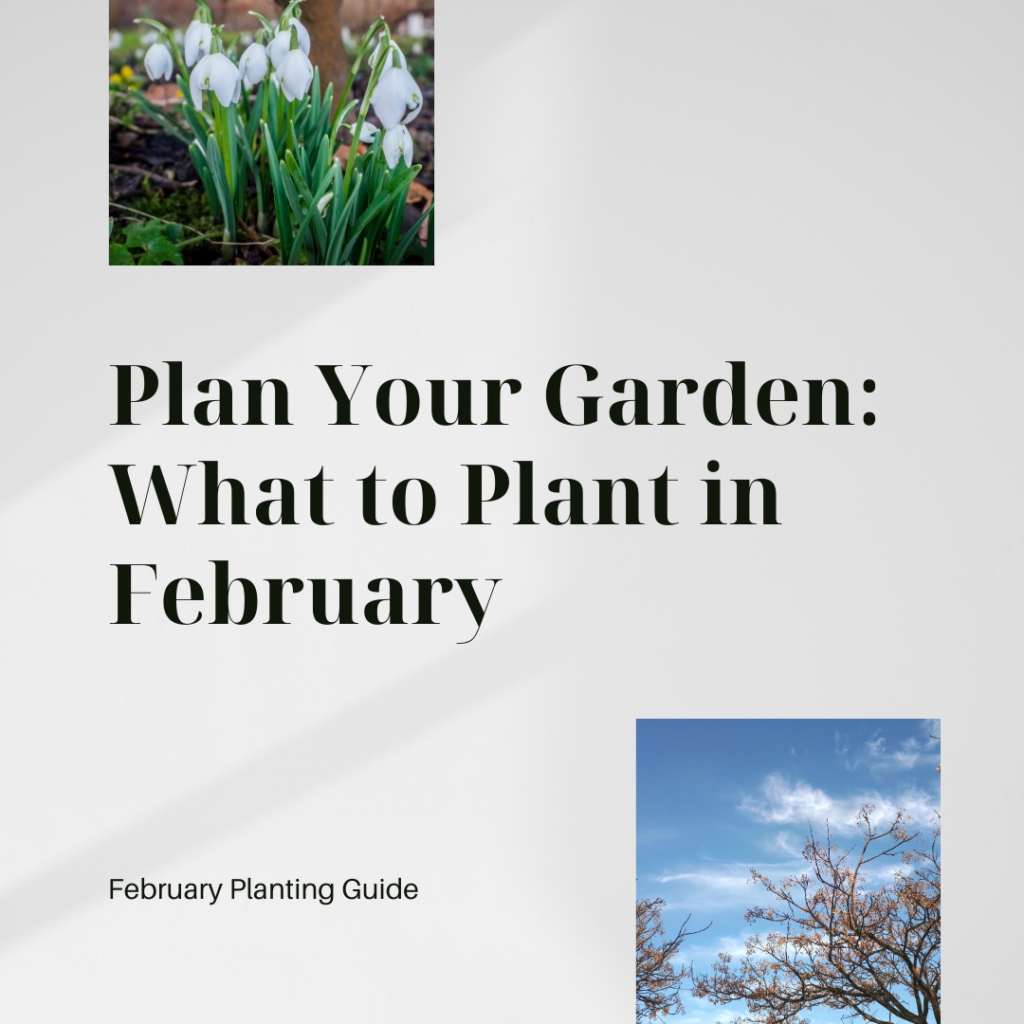
Welcome to February, the perfect time to start planning and planting your garden. As the winter weather begins to fade away, it’s time to prepare your outdoor oasis for the upcoming spring. Whether you have a spacious backyard or a cozy balcony, planting in February allows you to get a head start on the growing season and enjoy an early harvest. In this article, we will guide you on what to plant in your February garden, from vegetables to flowers.
Key Takeaways:
- February is an ideal time to start planting for an early spring harvest and beautiful blooms.
- Choose cold-tolerant vegetables that can withstand the remaining chill of winter.
- Select spring-blooming flower seeds that can be sown early to ensure vibrant colors.
- Consider growing herbs and greens indoors or in a greenhouse for year-round enjoyment.
- Proper garden preparation and care are essential for a successful planting season.
Early Season Vegetables for Planting in February
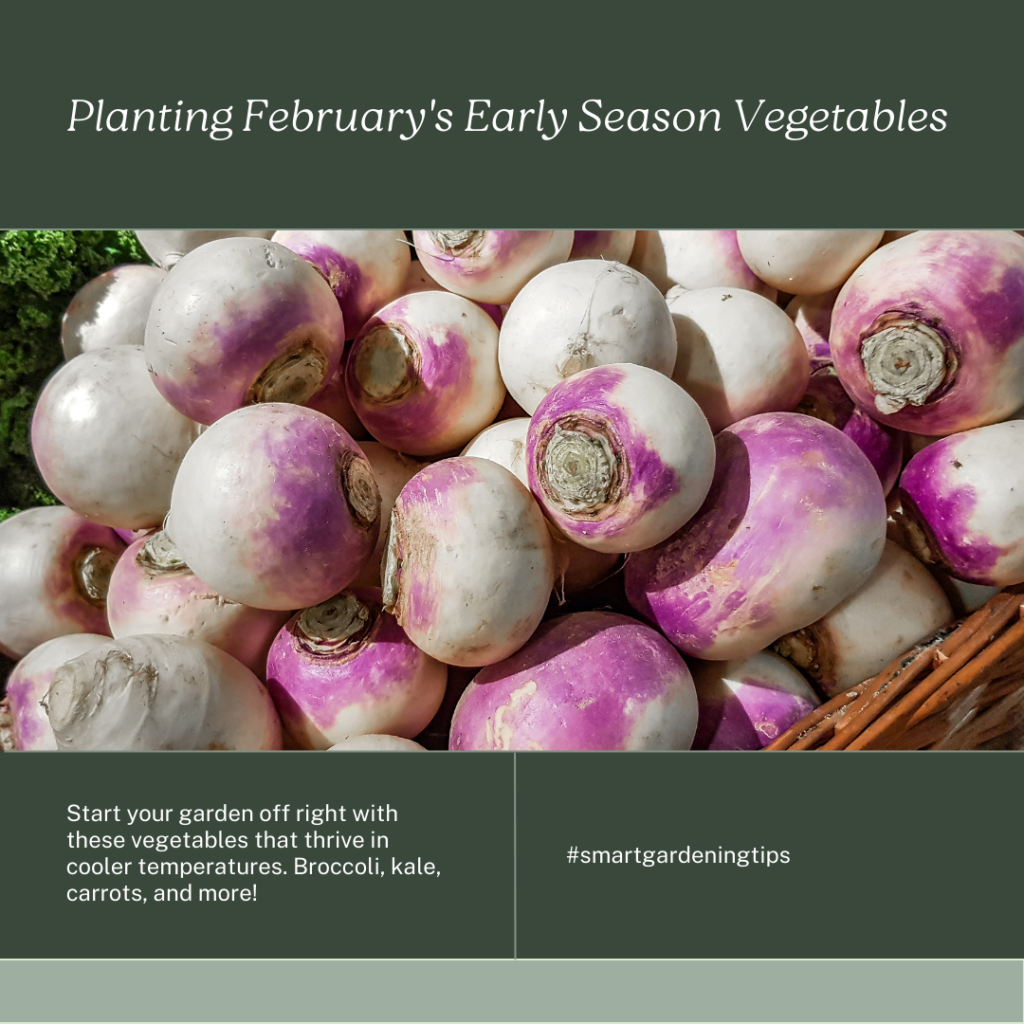
February is the perfect time to start planting early season vegetables that can withstand colder temperatures. These vegetables are hardy and can tolerate frost, allowing you to get a head start on your garden.
Here are some of the best cold-tolerant vegetables to plant in February:
| Vegetable | Sunlight Requirement | Days to Maturity | Spacing |
|---|---|---|---|
| Spinach | Full sun or partial shade | 40-45 days | 6-12 inches apart |
| Kale | Full sun or partial shade | 50-60 days | 12-18 inches apart |
| Carrots | Full sun | 50-80 days | 2-3 inches apart |
| Radishes | Full sun or partial shade | 20-30 days | 1-2 inches apart |
These vegetables can be sown directly in the soil or started indoors and transplanted once the weather warms up. Remember to provide adequate water, fertilizer, and ensure proper spacing for optimal growth.
By planting these early season vegetables in February, you can enjoy a bountiful harvest and fresh, homegrown produce earlier in the season. Get your garden off to a great start and savor the rewards of your efforts.
Spring-Blooming Flower Seeds to Sow Early
Sowing flower seeds in February is a strategic move that can bring your garden to life with vibrant colors when spring arrives. By starting early, you give these seeds ample time to germinate and grow into mature plants, ready to bloom and add beauty to your landscape. With careful planning, you can create a stunning floral display that will be the envy of your neighborhood.
Choosing the Right Spring-Blooming Flowers
When selecting flower seeds to sow in February, opt for varieties that are well-suited for early sowing. These flowers are typically cold-tolerant and capable of withstanding the remaining winter months. Some popular choices include:
- Tulips – A symbol of beauty and grace, tulips come in a wide range of colors, shapes, and sizes. These spring-blooming bulbs can be planted in February for a burst of color in your garden.
- Daffodils – With their cheerful yellow or white blooms, daffodils are a classic choice for early spring. Sow the bulbs in February, and you’ll be greeted by their vibrant flowers when winter fades away.
- Crocuses – These petite flowers bring a touch of elegance to any garden. Sow crocus corms in February, and they’ll reward you with delicate blossoms that emerge as winter recedes.
- Snowdrops – Snowdrops are small, bell-shaped flowers that signify the arrival of spring. Plant these bulbs in February, and their dainty white blooms will emerge, adding enchantment to your garden.
These are just a few examples of flowers that can be sown in February. Consider your climate, the amount of sunlight, and the type of soil in your garden when choosing the best spring-blooming flowers. Experiment with different varieties to add a diverse array of colors and textures to your garden.
Best Practices for Sowing Flower Seeds in February
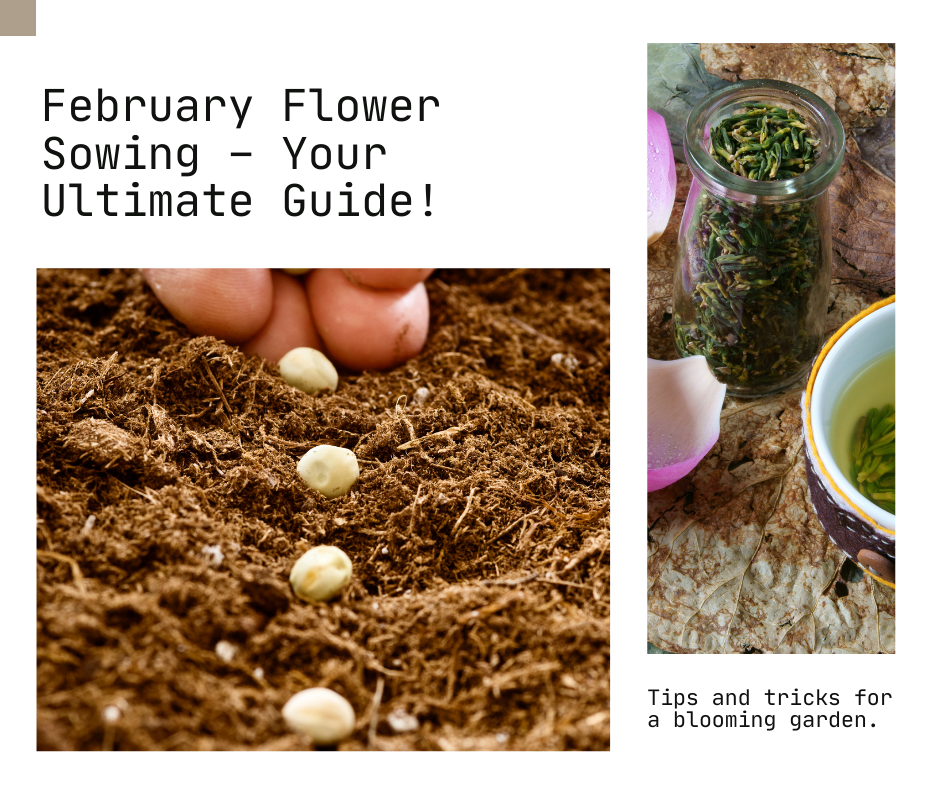
Raising flowers from seeds requires proper care and attention. Here are some tips to ensure successful germination and healthy growth of your February-sown flower seeds:
- Start indoors: Since it’s still winter, it’s best to start the seeds indoors. Create a conducive environment by using seed trays or pots, filled with moistened seed-starting mix.
- Provide sufficient light: Place your seed trays near a sunny window or use artificial grow lights to provide the necessary light for seed germination. Most flower seeds require at least 6-8 hours of sunlight a day.
- Water carefully: Keep the soil moist but not waterlogged. Overwatering can lead to rotting, while underwatering can hinder germination. Find the right balance by checking the moisture level regularly.
- Harden off before transplanting: Once spring approaches and the weather becomes milder, gradually introduce your seedlings to outdoor conditions. This process, known as hardening off, helps them acclimatize to the outdoor environment and reduces the risk of transplant shock.
By following these best practices, you’ll maximize the chances of success when sowing flower seeds in February. Soon enough, you’ll have a garden blooming with the vibrant colors of spring!
Planting spring-blooming flower seeds in February allows you to plan ahead and cultivate a garden filled with delightful blooms. With careful selection, proper sowing techniques, and a little bit of patience, your efforts will be rewarded with a colorful and vibrant display of flowers when spring finally arrives.
Herbs and Greens to Start in February
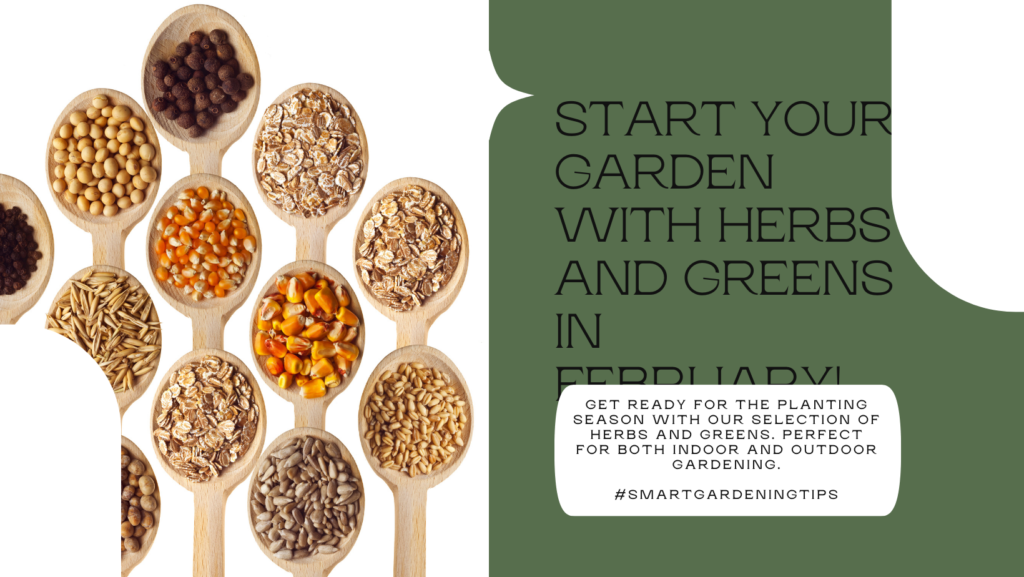
February is the perfect time to kickstart your herb and greens garden, whether you have limited indoor space or a greenhouse. These plants are known for their resilience to cooler temperatures, allowing you to enjoy their fresh flavors and vibrant colors all year round. Starting now gives them a head start, ensuring a bountiful harvest as the seasons change. We’ve compiled a list of herbs and leafy greens that are ideal for planting in February, along with tips to help you succeed in their cultivation.
Suggested Herbs and Leafy Greens for February Planting
| Herbs | Leafy Greens |
|---|---|
| Basil | Lettuce |
| Cilantro | Spinach |
| Parsley | Kale |
| Chives | Arugula |
| Oregano | Swiss Chard |
Note: This is not an exhaustive list, but it provides a great starting point for your February garden.
When planting herbs and leafy greens in February, it’s important to consider the specific requirements of each plant. They generally thrive in well-draining soil, so ensure proper drainage by incorporating organic matter or compost. Select a sunny spot indoors or optimize the light in your greenhouse to provide at least six hours of sunlight daily. Proper watering is crucial, as overwatering can lead to root rot. Remember to maintain consistent moisture levels and avoid letting the soil dry out completely. As your plants grow, regular harvesting will encourage bushier growth and a continuous supply of fresh greens and aromatic herbs.
By starting your herb and greens garden in February, you can indulge in a variety of culinary delights while uplifting your dishes with fresh flavors. The versatility and nutritional benefits of herbs and leafy greens make them an essential addition to any kitchen. Plus, the satisfaction of growing your own plants is truly rewarding.
For additional guidance and insights into successfully growing herbs and greens, refer to reputable gardening resources or seek advice from fellow gardeners. Experimenting with different varieties and techniques can expand your gardening knowledge and enhance your overall experience. Embrace the joy of nurturing nature indoors and commemorate February as the month you embarked on your herb and greens gardening journey.
Preparing Your Garden for Spring
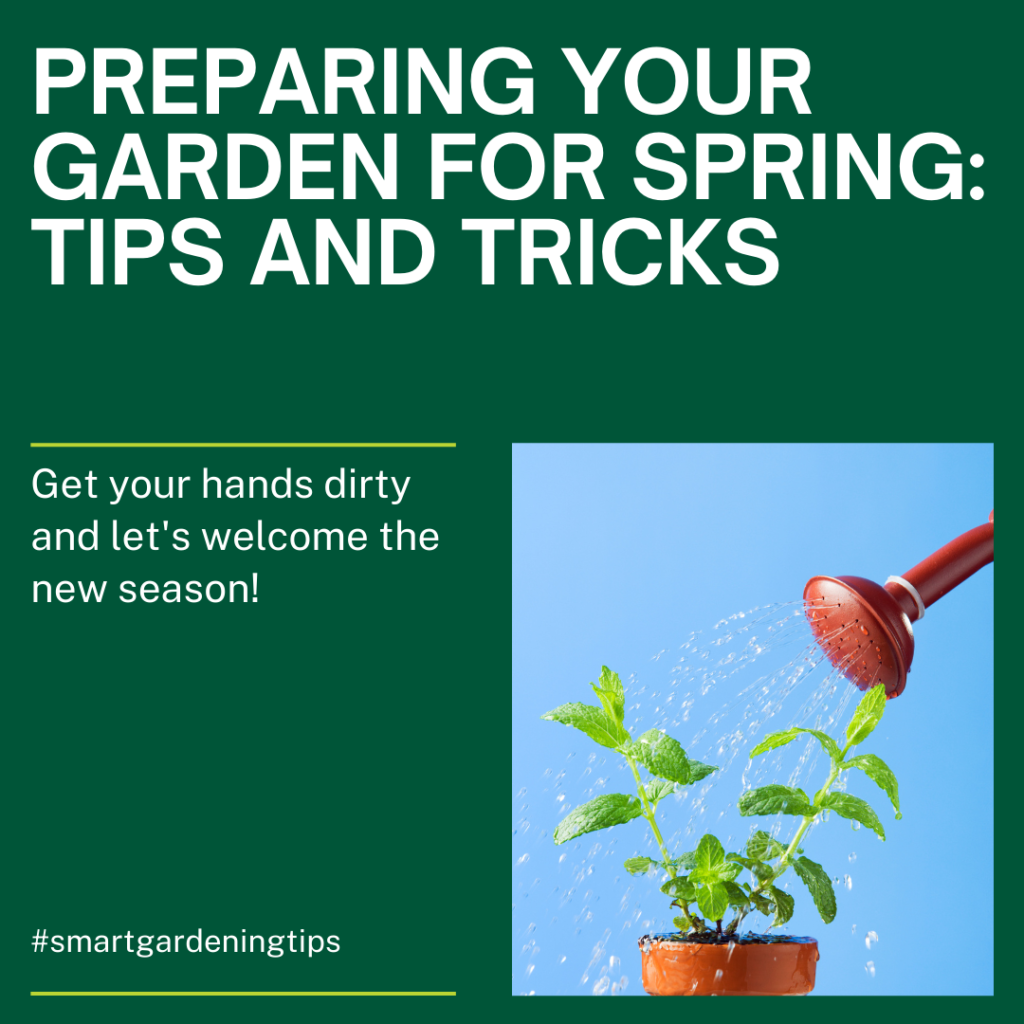
Proper preparation is crucial to ensure a successful garden season. As February marks the transition from winter to spring, it’s the perfect time to start preparing your garden for the upcoming growing season. By taking the right steps now, you can lay the foundation for healthy plants and bountiful harvests.
Soil Preparation
The key to a thriving garden lies in healthy soil. Before spring arrives, it’s essential to prepare your soil to provide optimal conditions for your plants. Here are a few steps to follow:
- Remove any weeds or debris from your garden beds.
- Loosen the soil with a garden fork or tiller, breaking up compacted areas.
- Add organic matter, such as compost or well-rotted manure, to enrich the soil.
- Ensure proper drainage by incorporating sand or perlite into heavy clay soils.
By improving your soil’s structure and nutrient content, you can promote healthy root development and enhance overall plant growth.
Fertilization
As the days get longer and plants start to wake up from their winter dormancy, providing supplemental nutrients through fertilization becomes crucial. Applying fertilizer in February helps replenish essential nutrients and gives your plants a head start. Here are a few tips for fertilizing your garden:
- Choose a balanced fertilizer with equal ratios of nitrogen, phosphorus, and potassium (N-P-K).
- Follow the instructions on the fertilizer package for the recommended application rate.
- Avoid over-fertilizing, as it can lead to nutrient imbalances and environmental pollution.
- Consider using organic fertilizers, such as compost or fish emulsion, for a more sustainable option.
Regular fertilization throughout the growing season will ensure that your plants have access to the nutrients they need for vigorous growth, abundant blooms, and a plentiful harvest.
Additional Steps
In addition to soil preparation and fertilization, there are a few more essential tasks to complete in February to get your garden ready for spring:
- Clean and sharpen your gardening tools to ensure they’re in good condition for the season ahead.
- Inspect and repair any damaged trellises, fences, or supports for your plants.
- Prune any dead or damaged branches from your trees and shrubs.
- Start planning your garden layout and decide which plants you want to grow.
By tackling these tasks now, you’ll be well-prepared for the flurry of activity in the spring when planting season is in full swing.
Remember, proper preparation in February sets the stage for a successful garden season. By dedicating time to soil preparation, fertilization, and completing important tasks, you’ll create an environment where your plants can thrive and flourish.
Getting Ready for the Upcoming Planting Season
As you get ready for the upcoming planting season, it’s important to prepare for potential pests and diseases that can pose a threat to your garden in February. By identifying these common issues and taking proactive measures, you can maintain a healthy and thriving garden.
Common Pests in February
During February, certain pests tend to emerge and cause damage to your plants. It’s crucial to be vigilant and watch out for these garden intruders:
- Aphids
- Slugs and snails
- Cabbage worms
- Spider mites
- Whiteflies
These pests can feed on your plants’ leaves, stems, and flowers, leading to stunted growth and potential crop loss. It’s essential to monitor your garden regularly and take immediate action if you spot any signs of infestation.
Preventive Measures and Management
To prevent and manage pests effectively, adopt the following practices:
- Implement proper sanitation by removing plant debris, keeping the garden clean, and regularly inspecting plants for signs of infestation.
- Encourage beneficial insects, such as ladybugs and lacewings, that feed on common garden pests.
- Use natural remedies like neem oil, insecticidal soaps, or homemade pest deterrents to control pests without harmful chemicals.
- Consider utilizing row covers or netting to physically prevent pests from reaching your plants.
- Rotate your crops each season to reduce the risk of pests building up in the soil.
Pest Prevention Table
| Pest | Description | Prevention | Management |
|---|---|---|---|
| Aphids | Tiny insects that suck sap, causing curling leaves and stunted growth. | – Regularly inspect plants and remove infested leaves. – Introduce beneficial insects like ladybugs. | – Apply insecticidal soap or neem oil. – Use a strong stream of water to wash off aphids. – Prune heavily infested parts of the plant. |
| Slugs and Snails | Nocturnal pests that feed on leaves, leaving behind slime trails. | – Remove hiding places like rocks and boards. – Avoid excessive mulching. – Set up beer traps to lure and drown slugs and snails. | – Handpick slugs and snails in the evening. – Apply organic slug control products. – Encourage natural predators like frogs and toads. |
| Cabbage Worms | Green larvae that chew through leaves, particularly brassicas. | – Cover plants with row covers to prevent adult butterflies from laying eggs. – Plant trap crops like nasturtiums to lure cabbage worms away from main crops. | – Handpick caterpillars and destroy them. – Apply organic insecticides like Bacillus thuringiensis (Bt). |
| Spider Mites | Tiny pests that feed on leaves, causing yellowing and webbing. | – Regularly spray plants with water to discourage mites. – Introduce predatory mites and insects like ladybugs and lacewings. | – Apply insecticidal soap or horticultural oil. – Prune heavily infested leaves and branches. – Maintain proper humidity levels. |
| Whiteflies | Small, winged insects that feed on leaves, causing yellowing and stunted growth. | – Use yellow sticky traps to monitor and trap adult whiteflies. – Introduce natural enemies like Encarsia wasps and predatory beetles. | – Apply insecticidal soap or neem oil. – Prune heavily infested leaves. – Minimize the use of chemical insecticides. |
Remember, prevention is key when it comes to pests and diseases in your garden. By practicing good garden hygiene, encouraging beneficial insects, and using safe pest management methods, you can minimize the risk of infestations and keep your plants healthy throughout the planting season.
Common Pests to Watch Out for in February
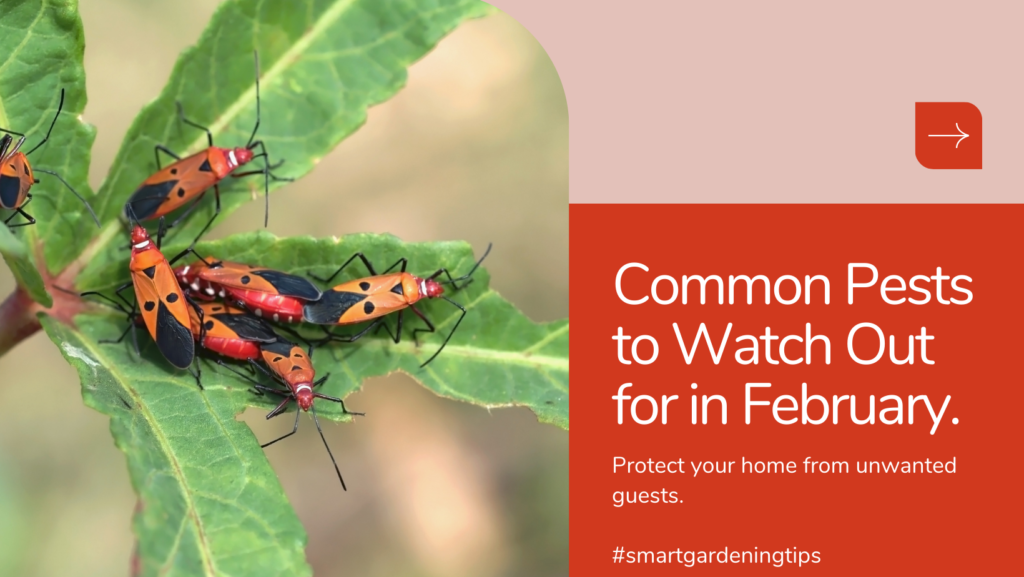
In February, your garden may be at risk of various common pests that can wreak havoc on your plants. By being aware of these potential intruders and taking proactive measures, you can effectively control and prevent their damage, ensuring a healthy and thriving garden. Let’s take a closer look at some of the pests you should watch out for:
Aphids
Aphids are small insects that can infest your plants, sucking the sap and causing stunted growth. They often cluster on new growth, undersides of leaves, and flower buds. To control aphids, you can:
- Introduce natural predators like ladybugs and lacewings.
- Use organic insecticidal soaps or horticultural oils.
- Prune infested plant parts.
Slugs and Snails
Slugs and snails can be particularly damaging to young seedlings and tender plants. They leave behind silvery slime trails and can devour entire plants overnight. To deter slugs and snails, consider these strategies:
- Remove debris and create dry barriers around plants.
- Set up beer traps or use copper tape to repel them.
- Encourage natural predators like frogs and birds.
Fungal Diseases
Winter gardens are susceptible to various fungal diseases due to cool and moist conditions. To prevent diseases from taking hold, it’s crucial to:
- Ensure proper air circulation by spacing plants adequately.
- Avoid overwatering and watering from above.
- Apply organic fungicides as a preventive measure.
By diligently monitoring your garden and implementing these preventive measures, you can reduce the risk of pest infestations and diseases in your winter garden.
Remember, a healthy garden starts with proactive care and attention. Stay vigilant, regularly inspect your plants, and take action at the first sign of trouble. Your efforts will be rewarded with a garden that thrives throughout the year.
Caring for Cold-Tolerant Vegetables in Winter

Once you have planted your early season vegetables in February, it’s crucial to provide them with the necessary care during the winter months. Cold-tolerant vegetables have unique requirements to ensure their survival and successful growth. By following these tips, you can protect your plants from frost and create optimal conditions for their development:
1. Protecting Your Plants from Frost
- Monitor the weather forecast regularly to anticipate frosty nights.
- When frost is expected, cover your vegetable beds with frost blankets or row covers.
- Ensure the covers are firmly secured to prevent cold drafts from reaching your plants.
2. Managing Watering in Colder Conditions
- Reduce watering frequency during winter, as plants have slower growth and require less moisture.
- Water your vegetables during the warmest part of the day to prevent water from freezing on the leaves.
- Avoid excessive watering, as over-saturated soil can lead to root rot in cold conditions.
3. Providing Additional Care Tips
- Apply mulch around the base of your plants to insulate the soil and retain moisture.
- Regularly inspect your vegetables for signs of pests or diseases and take appropriate action.
- Prune any damaged or diseased plant parts to promote healthy growth.
- Consider using a cold frame or a greenhouse to provide extra protection for your cold-tolerant vegetables.
By caring for your cold-tolerant vegetables in winter, you can ensure their survival and maximize their yields. Remember to adjust your care practices based on specific vegetable varieties and local climatic conditions.
| Vegetable | Care Requirements |
|---|---|
| Broccoli | – Provide consistent moisture – Protect from frost with row covers – Harvest heads before they flower |
| Kale | – Mulch to retain moisture and regulate temperature – Protect from extreme cold with frost blankets – Harvest outer leaves for continuous growth |
| Carrots | – Ensure well-draining soil to prevent rot – Mulch to regulate soil temperature – Harvest when roots reach desired size |
| Spinach | – Provide regular watering to keep soil moist – Protect from frost with frost blankets or cold frames – Harvest outer leaves for ongoing supply |
Growing Herbs Indoors or in a Greenhouse
Indoor herb gardening or utilizing a greenhouse allows you to enjoy fresh herbs year-round. Whether you lack outdoor space or want to extend your herb-growing season, growing herbs indoors or in a greenhouse is a convenient and rewarding option.
Advantages of Growing Herbs Indoors
Growing herbs indoors offers several benefits:
- Convenience: Having herbs in your kitchen or living area eliminates the need to step outside or visit the grocery store whenever you need fresh ingredients.
- Control: You have full control over the growing conditions, including temperature, lighting, and moisture levels. This allows you to tailor the environment to the specific needs of each herb.
- Pest-free: Indoor herbs are less susceptible to pests and diseases compared to outdoor plants, decreasing the risk of infestations and the need for chemical treatments.
Tips for Successful Indoor Herb Gardening
To ensure your indoor herb garden thrives, follow these tips:
- Choose the right location: Place your herb pots near a sunny window or provide supplemental grow lights to ensure they receive at least 6 hours of bright, indirect light each day.
- Select the appropriate containers: Opt for well-draining pots with drainage holes to prevent waterlogged soil. Use containers that are the right size for the specific herb, allowing room for root growth.
- Use quality potting soil: Use a well-draining potting mix designed for indoor plants to provide adequate aeration and nutrient uptake for your herbs.
- Water correctly: Herbs generally prefer slightly dry conditions, so water them when the top inch of soil feels dry. Avoid overwatering, as this can lead to root rot. Always check individual herb care requirements for precise watering instructions.
- Fertilize regularly: Feed your herbs with a balanced liquid fertilizer according to the package instructions to replenish nutrients in the confined space of a pot.
Growing Herbs in a Greenhouse
If you have access to a greenhouse, you can take herb gardening to the next level. Greenhouses provide a controlled environment that allows you to grow herbs with greater ease and success.
Advantages of Growing Herbs in a Greenhouse
Here are some advantages of greenhouse herb gardening:
- Extended growing season: Greenhouses provide a longer growing season, allowing you to start herbs earlier in the year and continue growing them well into the fall or even winter.
- Protection from the elements: Herbs grown in a greenhouse are sheltered from extreme weather conditions, such as frost, hail, and heavy rainfall. This protects them from damage and ensures consistent growth.
- Customizable environment: With a greenhouse, you have precise control over temperature, humidity, and ventilation. This enables you to create the ideal conditions for different herb varieties.
- Increased yield: A greenhouse provides optimal growing conditions, which can result in higher herb yields compared to outdoor gardening.
Tips for Successful Greenhouse Herb Gardening

Follow these tips to maximize your success with greenhouse herb gardening:
- Plan your layout: Organize your herb plants strategically, considering factors such as their growth habits, preferred lighting conditions, and compatibility.
- Monitor temperature and humidity: Invest in a thermometer and hygrometer to keep track of the greenhouse’s internal climate. Adjust the temperature and humidity levels as needed to accommodate the requirements of your herbs.
- Provide proper ventilation: Adequate airflow is essential to prevent mold, mildew, and insect infestations. Install vents, fans, or louvers to maintain good air circulation within the greenhouse.
- Pest control: Despite the protective environment, pests can still find their way into the greenhouse. Regularly inspect your herbs for any signs of pest activity and implement organic pest control methods if necessary.
- Regular maintenance: Clean your greenhouse regularly to prevent the buildup of debris and pathogens. Prune herbs to maintain their shape and remove any dead or diseased foliage.
By growing herbs indoors or in a greenhouse, you can enjoy a bountiful supply of fresh herbs all year long. Whether you choose to create an indoor herb garden or take advantage of the controlled environment of a greenhouse, the rewards of having your own flavorful herbs within arm’s reach will enhance your culinary experiences.
Preventing Diseases in Your Winter Garden
Winter weather can create conditions that are conducive to the development of diseases in your garden. It’s important to be proactive and take steps to prevent these diseases from affecting your plants. By implementing preventive measures, you can ensure a healthy garden throughout the winter months and beyond.
Common Winter Garden Diseases

During the winter season, certain diseases can thrive due to cold and damp conditions. Here are some of the common diseases that you may encounter in your winter garden:
- Fungal diseases: Conditions such as powdery mildew, gray mold, and root rot can be prevalent during winter months. These diseases thrive in cool and moist environments.
- Bacterial diseases: Winter weather can create ideal conditions for bacterial infections in plants. Diseases like bacterial leaf spot and crown gall can spread rapidly if not addressed.
- Viruses: Some plant viruses can become more active in colder temperatures. Tomato mosaic virus and cucumber mosaic virus are examples of winter viruses that can affect your garden.
Strategies for Disease Prevention
To minimize the risk of diseases in your winter garden, consider the following preventive strategies:
- Clean up garden debris: Remove any fallen leaves, dead plant matter, or decaying material from your garden. These can serve as breeding grounds for diseases and pests.
- Practice crop rotation: Rotate crops in your garden to disrupt the life cycles of pests and diseases. This can help prevent the buildup of pathogens in the soil.
- Provide proper airflow: Adequate air circulation is essential for preventing the growth and spread of diseases. Avoid overcrowding plants and prune any dense foliage to improve airflow.
- Water plants carefully: Overwatering can create ideal conditions for disease development. Water your plants at the base to avoid wetting the leaves, as wet foliage is more susceptible to infections.
- Use disease-resistant varieties: Choose plant varieties that are known to be resistant to common diseases in your area. This can significantly reduce the risk of infection.
- Apply organic fungicides: Consider using organic fungicides as a preventive measure. These can help control fungal diseases while minimizing harm to beneficial insects and the environment.
By following these strategies, you can create an environment that is less favorable for diseases in your winter garden. Remember to monitor your plants regularly for any signs of disease and take immediate action if needed.
FAQ
Q. What are the best vegetables to plant in your February garden?
A. In February, you can start planting cold-tolerant vegetables such as broccoli, cabbage, carrots, kale, lettuce, peas, radishes, and spinach. These vegetables can withstand cooler temperatures and even light frost, allowing for an early spring harvest.
Q. What are some early season vegetables for planting in February?
A. Some early season vegetables that thrive when planted in February include beets, onions, potatoes, turnips, and Swiss chard. These vegetables can handle colder temperatures and will be ready for harvest before the heat of summer arrives.
Q. Which flowers should I sow in February for spring blooms?
A. To enjoy a colorful spring garden, consider sowing flower seeds such as cosmos, pansies, snapdragons, sweet peas, and violas in February. These flowers will have ample time to develop and will reward you with vibrant blooms once spring arrives.
Q. What are some herbs and greens that I can start in February?
A. In February, you can start growing herbs like basil, chives, cilantro, dill, and parsley indoors or in a greenhouse. For leafy greens, consider planting arugula, lettuce, spinach, and kale. These plants thrive in cooler temperatures and can provide you with fresh flavors throughout the year.
Q. How can I prepare my garden for spring?
A. To prepare your garden for spring, start by clearing away any debris or weeds. Then, focus on improving the soil by incorporating organic matter, such as compost. It’s also a good time to fertilize the soil and address any drainage issues. Lastly, consider planning your garden layout and ordering any necessary seeds or plants.
Q. What should I do to get ready for the upcoming planting season?
A. As you prepare for the upcoming planting season, be mindful of common pests and diseases that may affect your garden in February. Keep an eye out for pests like aphids, slugs, and snails, and take preventive measures to protect your plants. Additionally, practice good garden hygiene, such as cleaning tools and removing diseased plants, to minimize the risk of diseases.
Q. What pests should I watch out for in February?
A. In February, you should be on the lookout for pests such as aphids, cabbage worms, and spider mites. These pests can cause damage to your plants if left unchecked. Regularly inspect your garden and use organic pest control methods to keep these pests at bay.
Q. How can I care for cold-tolerant vegetables during winter?
A. Once you have planted cold-tolerant vegetables in February, it’s important to protect them from frost by covering them with frost cloth or mulch. Be mindful of watering, as cold temperatures may reduce the need for frequent watering. Additionally, provide any necessary support, such as staking, to prevent damage from strong winds.
Q. What are some tips for growing herbs indoors or in a greenhouse?
A. When growing herbs indoors or in a greenhouse, choose a sunny location and provide adequate light using grow lights if needed. Ensure proper drainage by using well-draining pots and potting mix. Regularly monitor moisture levels and avoid overwatering. Lastly, consider using organic fertilizers to provide essential nutrients for healthy herb growth.
Q. How can I prevent diseases in my winter garden?
A. To prevent diseases in your winter garden, practice good garden hygiene by removing any diseased plants promptly. Avoid overcrowding plants to improve air circulation and reduce the spread of diseases. Additionally, consider applying organic fungicides or using disease-resistant plant varieties. Regularly monitor your plants for signs of diseases and take appropriate action if necessary.
Conclusion
In conclusion, February is an exciting month for gardeners as it marks the beginning of the planting season. By carefully selecting the right vegetables, flowers, and herbs and following proper care practices, you can lay the foundation for a fruitful and beautiful garden. Whether you’re starting seeds indoors or preparing your outdoor garden, the rewards of planting in February will be evident in the months to come.
With early season vegetables, you can enjoy an abundant harvest before spring arrives. Cold-tolerant varieties like kale and spinach thrive in February and provide you with a fresh and nutritious supply. Sowing spring-blooming flower seeds early ensures a colorful garden once warmer weather arrives, bringing joy and beauty to your outdoor space.
Herbs and greens are also perfect for starting in February. By growing them indoors or in a greenhouse, you can enjoy the flavors of your favorite herbs year-round. Additionally, by taking the time to prepare your garden for spring and being proactive in preventing pests and diseases, you can create a healthy and vibrant garden that will flourish throughout the year.
So, roll up your sleeves, put on your gardening gloves, and get ready to embrace the wonders of planting in February. Your dedication and care will be rewarded with a bountiful harvest, stunning blooms, and the satisfaction of nurturing nature’s gifts. Happy gardening!
















